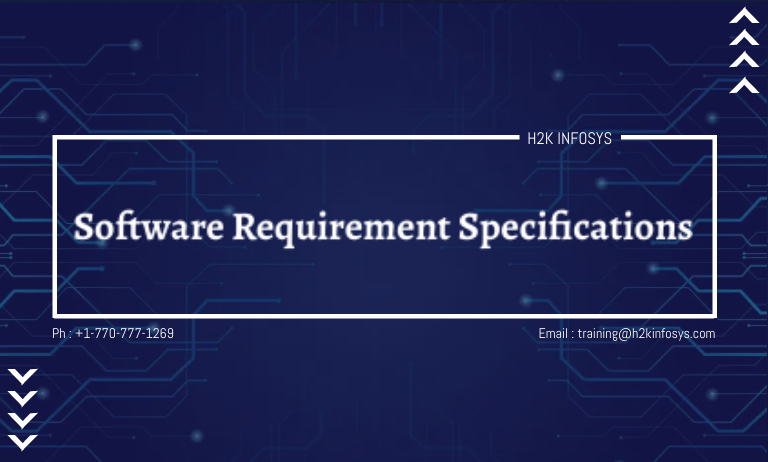Introduction:
In the world of software development, clear communication between stakeholders, developers, and testers is essential. This is where Software Requirement Specifications (SRS) come into play. Often described as the “blueprint” for software projects, SRS ensures that all parties involved understand the requirements and expectations from the outset. For QA professionals, mastering SRS is a critical skill. Through QA software training, professionals learn to interpret, analyze, and validate these documents, forming the backbone of their testing strategies.
If you’re pursuing software quality assurance training, understanding SRS is not optional it’s a necessity. Let’s dive deep into what SRS entails, its importance, and how QA professionals can leverage it to ensure flawless software delivery.
Value of good SRS
They will serve as the frame of written document for the communication between clients who have been placed an order for the software development on the payment which is based upon the software contract that has been accepted to develop and deliver the requisite software.
End-users of the software system, a client who has ordered the software for the purchase, and also the suppliers who have agreed to develop and supply. Three will have to communicate and comment purely on the basis of SRS. High-quality SRS will be precise in the description of the proposed software which means it will specify and finalize the end-users requirements.
Role of SRS
The main objective of the requirement analysis activity is to understand the problem, guess the situation of client’s organization. SRS should not be confusing or informal that would generate the wrong interpretation of the system. As it may further lead to misunderstandings. The key role of SRS is to minimize the potential conflicts or to overcome misunderstandings that may come in the future.
To avoid using SRS documents we need to check which can be established and then clarify the delivered software which satisfies all the customers’ needs
Requirement process:
There are various processes that are carried out. They include:
As an engineer, a process where SRS will be produced after the feasibility studying and problem analysis.
Three basis tasks or the activities concerning requirements process are:
- Requirement analysis
- Requirement specification
- Requirement validation
Requirement analysis
This is also called the analysis which will be a process to obtain the exact needs of the client and end-users which will be expected from the software system when it’s been put to use. The analysis will lead to the actual specifications and also their validation along with possible constraints where the software is being developed. The analysis involves a series of discussions, interviewing the end-users and clients for charting out the expected services from the software system being developed.
People from the software vendor who perform the problem analysis are often referred to as the requirement analysis or the counselor or the consultant for their different roles which are being played. Software development staff not only collect and organize information about clients’ organizations and their processes but also act as consultants for the clients and end-users in order to identify their actual needs.
Requirement specifications
The requirement specifications activity will generate the SRS that is software requirement specifications for the final document which is based on the problem which is being analyzed in the first activity. Requirement specifications will be prepared and finalized on basis of the contract and bond which is signed between the system developer and the client. Requirement specifications will be precise descriptions of the software system’s intended functionality which is the possible constraint.
Requirement validation
This phase will be a critical process of checking the requirement for the validation. Principal techniques will be used for the requirement validation which includes requirement review and also the prototyping.
What is a Software Requirement Specification?
An SRS document outlines all the functional and non-functional requirements of a software system. It acts as a contract between stakeholders and development teams, specifying what needs to be built and how it should perform.
Key Components of an SRS:
- Purpose: Why the software is being developed.
- Scope: The boundaries of the project.
- Definitions: Key terms to avoid ambiguity.
- Functional Requirements: Features the software must deliver.
- Non-Functional Requirements: Performance, usability, security, and other constraints.
- Assumptions and Dependencies: External factors influencing the project.
Why is SRS Crucial for Quality Assurance?
For QA testers, SRS is more than a document it’s the foundation of their work. Here’s why:
- Test Case Creation: Every test case stems from the requirements outlined in the SRS.
- Bug Identification: Understanding SRS ensures testers can spot deviations from specified requirements.
- Risk Mitigation: Clear requirements minimize misunderstandings, reducing project risks.
- Improved Communication: A well-documented SRS facilitates smooth communication among team members.
Real-World Example: How SRS Saves the Day
Consider a mobile banking app. An SRS might specify that the app must:
- Allow users to transfer funds within 5 seconds.
- Support biometric authentication for login.
- Be accessible on both iOS and Android platforms.
If the SRS is clear, the QA team can:
- Develop test cases to verify fund transfer speed.
- Test biometric authentication under various conditions.
- Ensure cross-platform functionality meets the outlined requirements.
Without an SRS, QA teams would work with vague assumptions, leading to missed defects and frustrated stakeholders.
Types of Software Requirements
SRS documents typically include two main types of requirements:
Functional Requirements
These define what the system should do—the features, data handling, and system behavior in response to user inputs.
Examples:
- The system shall allow users to log in using email and password.
- The system shall generate monthly financial reports.
Non-Functional Requirements
These specify how the system should perform. They often include performance metrics, security standards, usability, and scalability.
Examples:
- The system shall respond to user actions within 2 seconds.
- The system must encrypt all data transmissions.
Role of SRS in QA Testing Online Training
In a QA software training program, professionals learn to use SRS effectively to ensure software quality. Here’s how:
Understanding Requirements
Trainees are taught to dissect SRS documents, identify key requirements, and classify them as functional or non-functional.
Creating Test Scenarios
Participants learn to map requirements to test scenarios and cases, ensuring comprehensive coverage.
Requirement Traceability Matrix (RTM)
Trainees practice building RTMs to track every requirement from the SRS through development, testing, and deployment.
Validating Requirements
Practical exercises involve verifying the feasibility and clarity of requirements, a skill crucial for avoiding misinterpretations.
Tools Used for SRS Documentation
There are several tools to help create and manage SRS documents effectively:
- Microsoft Word / Google Docs: Common for small and medium teams.
- Atlassian Confluence + Jira: Excellent for collaborative documentation with traceability.
- IBM Rational DOORS: Enterprise-level requirements management.
- Visual Paradigm, Lucidchart: Helpful for including diagrams and use case flows.
Some teams also integrate their SRS documentation into agile tools like Notion, ClickUp, or Trello, especially when practicing iterative development.
Conclusion:
Mastering Software Requirement Specifications is non-negotiable for QA professionals. Whether you’re testing an e-commerce app or mission-critical healthcare software, SRS forms the foundation for successful quality assurance. Through comprehensive QA software training at H2K Infosys, you’ll gain hands-on experience with SRS, empowering you to excel in your career.
Call to Action
Take the first step toward a successful QA career. Enroll in H2K Infosys’ QA software training to gain practical expertise in SRS, testing strategies, and industry-relevant skills. Empower your future start today!






























7 Responses
Software Requirement Specifications: A software requirements specification (SRS) is a description of a software system to be developed. It serves as a frame of reference for both clients as well as software. A software requirements specification (SRS) is a document that describes what the software will do and how it will be expected to perform. It also describes the functionality the product needs to fulfill all stakeholders (business, users) needs. The main objective of the requirement analysis activity is to understand the problem, guess the situation of client’s organization. SRS should not be confusing or informal that would generate the wrong interpretation of the system. The key role of SRS is to minimize the potential conflicts or to overcome misunderstandings that may come in the future. The best SRS documents define how the software will interact when embedded in hardware — or when connected to other software.
Three basis tasks or the activities of requirements process are:
Requirement analysis -This is also called the analysis which will be a process to obtain the exact needs of the client and end-users which will be expected from the software system when it’s been put to use.
Requirement specification -The requirement specifications activity will generate the SRS that is software requirement specifications for the final document which is based on the problem which is being analyzed in the first activity.
Requirement validation -This phase will be a critical process of checking the requirement for the validation.
A software requirements specification (SRS) is a document that describes about what the software will do and how it will be expected to perform. It also describes the functionality the product need to fulfill all stakeholders (like business, users) needs.
An SRS gives a complete picture of entire project. It provides a single source of truth that every team involved in development will follow. It is a plan of action and keeps all teams, from development to maintenance.
This layout not only keeps the teams in sync but it also ensures that each requirement is hit. It can ultimately help of making vital decisions on product’s lifecycle, such as when to retire an obsolete feature.
The time it takes to write an SRS is given back in the development phase. It allows for better understanding or your product, team, and the time it will take to complete.
SRS(Software requirement specifications) are documents that have the description of the system requirements. It works as a frame of reference for both clients and software developers. So validating a SRS is very important before moving to the next phase of the software development. High-quality SRS will be precise in the description of the proposed software which means it will specify and finalize the end-users requirements.
Three steps of requirement process are:
Requirement analysis
Requirement specification
Requirement validation
Software requirement specifications are documents that have the description of the system requirements. It serves as a frame of reference for both clients as well as software developers. It’s the most important thing that the SRS documents will be validated before the next phase of the software development.Requirement specifications
The requirement specifications activity will generate the SRS that is software requirement specifications for the final document which is based on the problem which is being analyzed in the first activity.
A software requirements specification (SRS) is a document that describes about what the software will do and how it will be expected to perform. It also describes the functionality the product need to fulfill all stakeholders (like business, users) needs.
An SRS gives a complete picture of entire project. It provides a single source of truth that every team involved in development will follow. It is a plan of action and keeps all teams, from development to maintenance.
This layout not only keeps the teams in sync but it also ensures that each requirement is hit. It can ultimately help of making vital decisions on product’s lifecycle, such as when to retire an obsolete feature.
The time it takes to write an SRS is given back in the development phase. It allows for better understanding or your product, team, and the time it will take to complete.
The requirement specifications activity will generate the SRS that is software requirement specifications for the final document which is based on the problem which is being analyzed in the first activity. Requirement specifications will be prepared and finalized on basis of the contract and bond which is signed between the system developer and the client. Requirement specifications will be precise descriptions of the software system’s intended functionality which is the possible constraint